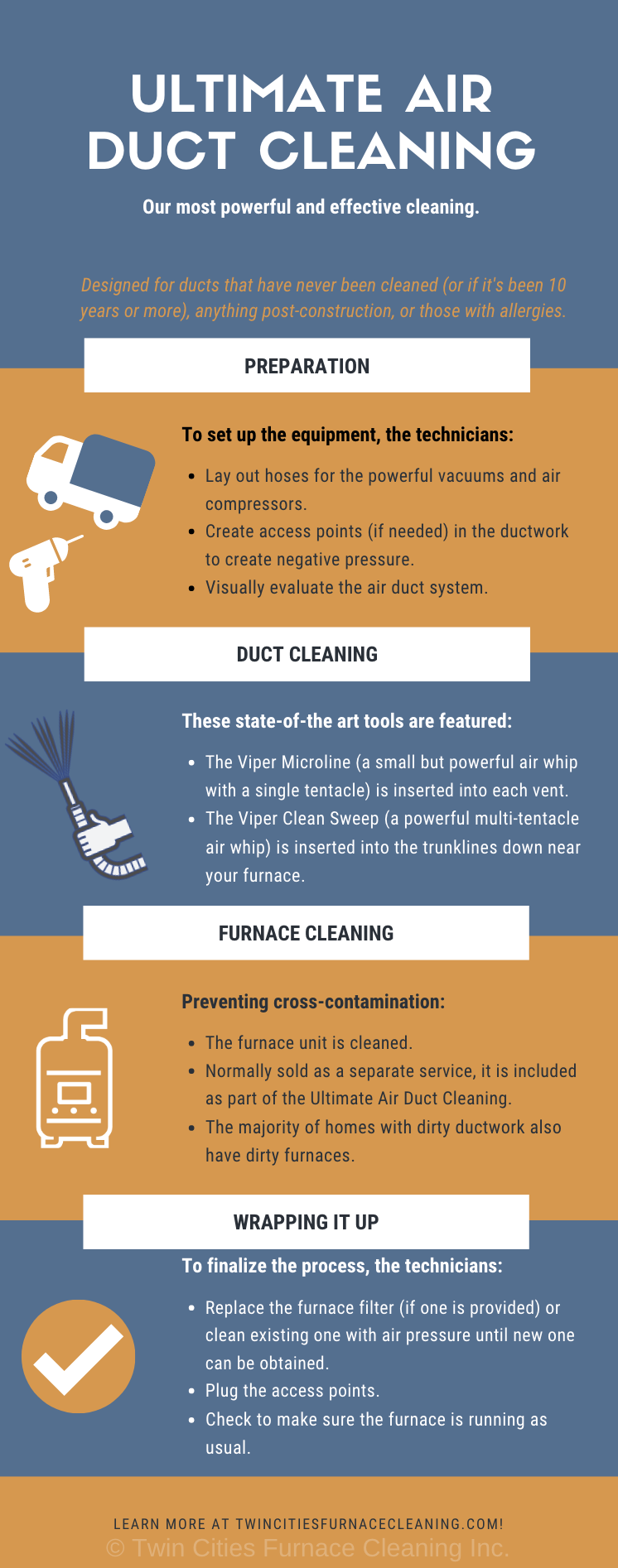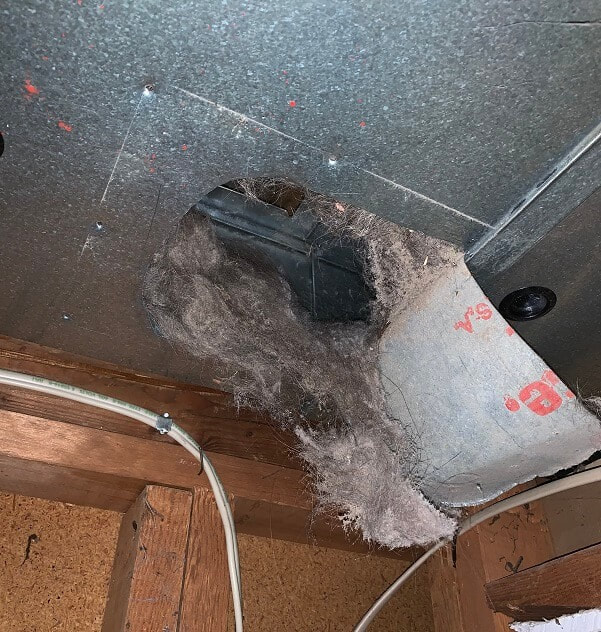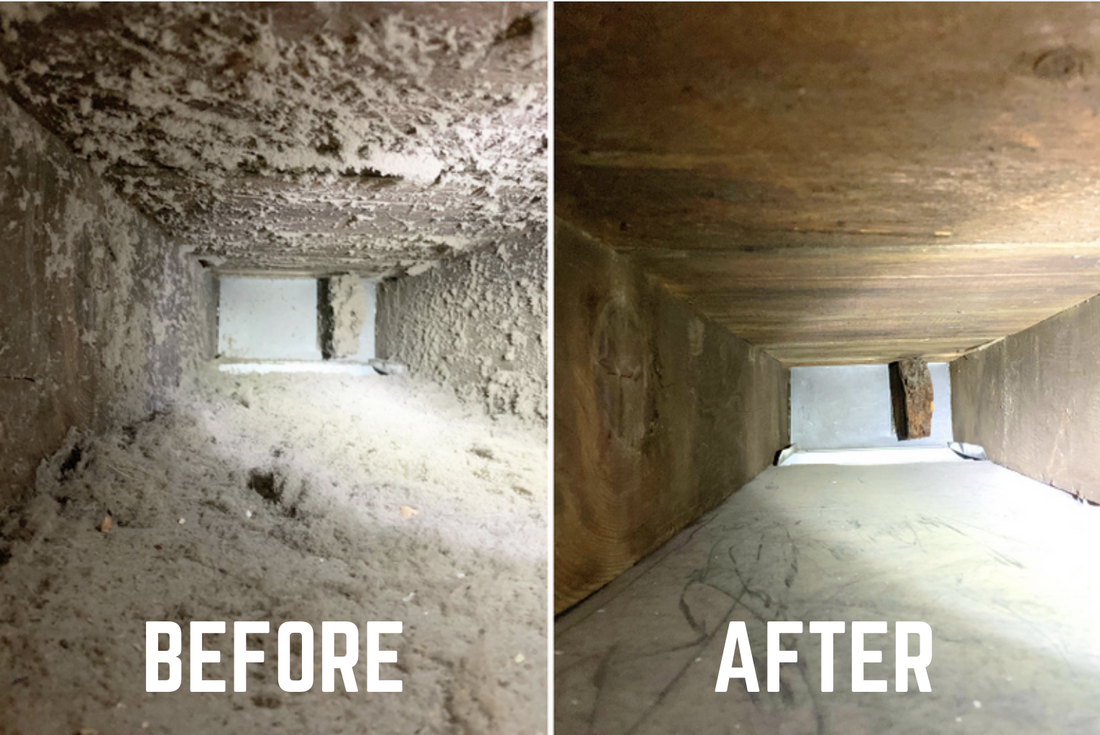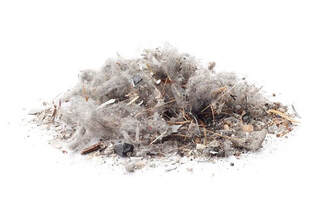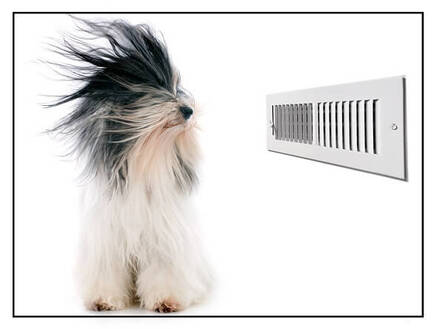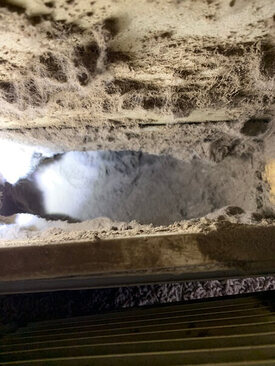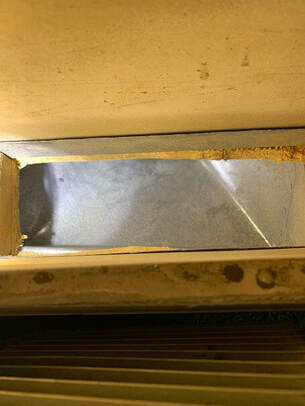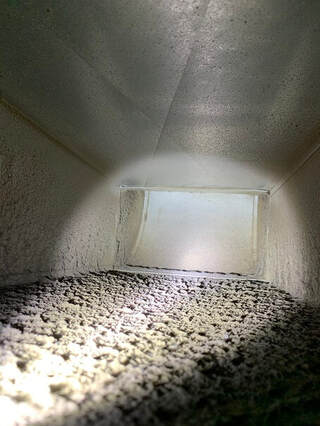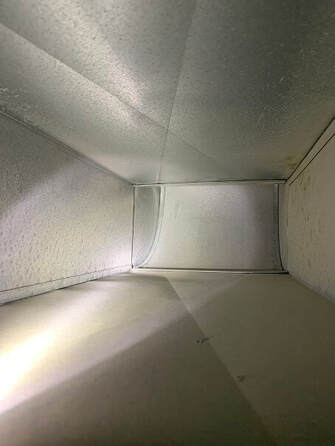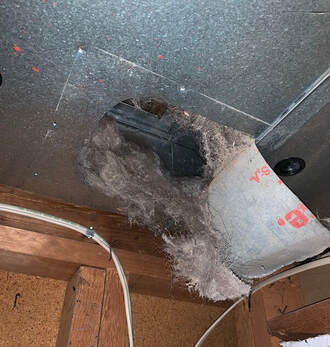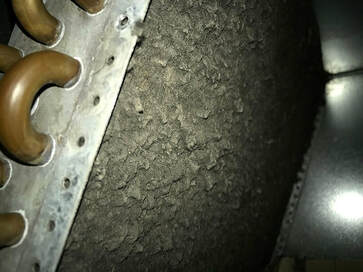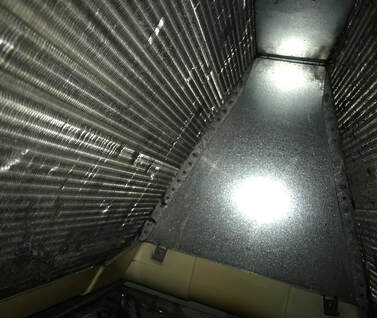|
Did you know our most powerful cleaning was designed by our own experts who have 15-20 years of HVAC-cleaning experience? ✨
0 Comments
A message of thanks for the customer feedback that has allowed us to reach over 1,000 organic Google reviews with an average of 4.9-star rating! All given by real customers like YOU!
The benefits of cleaning your air ducts.The benefits of air duct cleaning run the gamut from health-related to financial. Your furnace and ductwork serve as your home's respiratory system, pulling air from inside your home through the return ducts, where the air moves through the air filter into the furnace to be heated before passing through the supply ducts and back into your living space. Dust, pet fur, debris, pathogens, allergens, chemicals, dust mites—all of these contaminants become trapped inside your air ducts over time, and as the air moves through the system, it passes through these dirty ducts, redistributing the dirt throughout your home or simply depositing it in the ducts where it builds up over time. Air duct cleaning can dramatically reduce the number of contaminants present in your home's indoor air. *Photo taken in the field by our very own technician. Notice the amount fur built up in the air duct system. Cleaning the air ducts in your home increases air flow within the system, helping to improve the efficiency of the HVAC system by distributing air throughout the house more quickly and with less effort. Regular cleaning of the air ducts also minimizes dust and debris entering the furnace, thereby helping to prevent clogging of the unit.
Curious about the air duct cleaning services we offer with straightforward pricing? Air Duct Cleaning: Recommended FrequencyAir duct cleaning is typically recommended every one to three years. Some reasons to clean more frequently include pets in the home, occupants who have allergies or asthma, and remodeling or construction work. The latter especially causes large amounts of dust and debris to be generated, which can clog up HVAC system parts—reducing system efficiency and decreasing indoor air quality. You'd be surprised by the things we find inside air ducts!
If you are not sure whether an air duct cleaning is needed, have a look at some of the visible components of the system—the register covers and the vents just behind them, and your furnace itself. If a fair amount of dust is visibly present, it's fair to assume there's a similar amount inside the ducts themselves. When in doubt, you can sign up for the lowest level of service (Standard), and the technician can perform an assessment before work begins.
Curious about the air duct cleaning services we offer with straightforward pricing? *Photo shows results of our Ultimate Air Duct Cleaning. The cleaning of air ducts is accomplished with the use of a variety of tools:
Because of the multitude of HVAC configurations and various scenarios that present themselves during an air duct cleaning service, technician experience can play a key role in the quality of service delivered. An experienced tech can gauge the quality of any previous duct cleaning work, appropriately assess the current level of cleaning needed, and successfully troubleshoot difficult jobs. Interested in the basics of residential air duct cleaning? Having trouble deciding which process is best for your home? Visit our blog article: Which Level of Air Duct Cleaning Should I Choose? Want to schedule with us? Spring has finally arrived in Minnesota! Your HVAC system has been working hard for the last 6 months, keeping you comfortable and safe—even through the polar vortex. If you didn't get to it in the fall—and let's face it, a lot of us didn't—now's the time to give it the cleaning it deserves Furnace Cleaning
Your furnace is one of the most valuable and hardworking appliances in your home. Its work doesn't stop once winter comes to a close. Instead, it's called into service again all summer long, to distribute throughout your home the air that your evaporator coil (A-coil) cools with the help of the outside condenser. If the inner components of your furnace are dirty, your furnace will have to work harder and use more energy to distribute air. Dust on the fan blades, for example, will put more stress on the motor and decrease efficiency. Having relied on your furnace all winter, before summoning it into service again for the summer, show it some gratitude by having your furnace cleaned and checked. Air Duct Cleaning During the long Minnesota winter, your air ducts were hard at work circulating warmed air throughout your closed-up home. Over time, household dust and debris accumulate inside the air ducts. Left uncleaned, this accumulation of debris continues to build up and is eventually blown back into your living space, polluting your indoor air. The buildup additionally settles in the components of your furnace and evaporator coil, hindering their performance and decreasing air flow. To rid your system of these indoor pollutants, have your air ducts cleaned of all of the debris within, to improve indoor air quality and increase system efficiency. Chimney Sweep Chimney sweeping is recommended after approximately every 50 fires. If you didn't have your chimney cleaned in the fall, consider having it swept this spring in order to avoid the danger of excessive creosote buildup. An advantage of having it cleaned in the spring is that this is the slow season for this service; many homeowners don't start thinking about chimney sweeping till fall, by which time chimney sweeps are harder to come by and sometimes more pricey--especially during the pre-holiday rush from mid-October to late December. Also, your chimney sweep will often need to climb your roof to do a thorough job. Wait until fall and you'll risk having to postpone the service if snow falls early and your roof is too risky to climb. Dryer Vent Cleaning Dryer lint is an extreme fire hazard, and regular and thorough removal of lint buildup inside the vent is critical to home fire safety. Additionally, wildlife often seek the warmth of this deceptively cozy environment, potentially causing dangerous blockages. Consider having your dryer vent cleaned when you clean the various components of your HVAC system. Having the service performed in the spring is especially good timing if your dryer vents onto the roof, which is often dangerous to climb in the fall and winter seasons. AC Tuneup & Cleaning While your furnace is working inside to distribute air, your outside condenser is circulating coolant through the furnace's A-coil and expelling heat outside. The condenser fins on the unit, over time, become clogged with debris, including dirt, dead leaves, and all manner of fluffy-floaty plant progeny (dandelion seeds come to mind) that sail through the air and get sucked in by the fan. When the central fan draws air in through fins that are clogged with debris, the air conditioning unit suffers from reduced efficiency and is more subject to breakdowns. Additionally, the debris hinders air flow and can cause the unit to not cool properly (as can low refrigerant levels). Want to learn more about our HVAC services? Our service pages contain detailed descriptions about the processes and tools each service entails. It’s a fair question. It stands to reason that using powerful equipment to blow and suck dirt in order to move it from inside your ducts to an industrial containment off-site might result in some residual debris or airborne dust in your house. But how much is acceptable, and how much is normal? A good tech from a reputable company should do everything they can to minimize this nuisance Preliminary precautions to keep your home clean
The first thing any tech should do when entering your home is either remove their shoes or place booties over them to prevent depositing onto your floor whatever was on their soles. They’ll also likely lay down tarps to protect your flooring from the large vacuum hose that will run from their truck down to your furnace (unless they’re using portable equipment). Some technicians will up the meticulousness factor further by placing corner guards to protect wall corners from any potential damage. In order to position the vacuum hose in your main trunk line, they’ll need to cut access into it, and for this task they’ll probably use tin snips. To prevent those tiny metal shavings from falling onto your floor (ouch!), there are products, such as Chipmaster, that collect the shards before they fall. Any technician not taking this simple precaution should cleanly sweep them up. Another precaution they may take, depending on how large your home is and what level of cleaning you’ve selected, is to cover the vents with adhesive or magnetic vent covers. These aid in keeping the dust level down when each of the other vents are being serviced with the cleaning tools. The covers can also help to create extra suction power. On a smaller system (under 2500 sq ft), they may not be needed and in fact may be counterproductive because of the sheer force of the vacuum. During the service Most air duct cleanings work by utilizing the power of negative pressure. An industrial-strength vacuum is hooked into the trunk line near the furnace. Then, with the system under negative pressure, the technician services each vent, room by room, with various tools designed to move debris from the branch lines to the trunk, where it's captured by the vacuum. This negative pressure is the key component to minimizing the blow-back of debris into the house: all of the force or pressure exerted by the tools is directed toward the vacuum, increasing the negative air flow. Any vent covers placed over the registers will help in this process, both by creating more suction and by preventing debris from exiting the vents that aren't being serviced. In some cases, especially when the vents are particularly dirty, a small amount of dust from the corner of the vent will go airborne briefly in a small poof when the tool is initially engaged, usually being quickly sucked back into the system shortly thereafter. When things go wrong Things don't always go according to plan, of course, and sometimes despite the best intentions more dust than we'd like escapes the system and enters the living space. There are a few scenarios under which this could happen. In some cases when additions are constructed onto houses or retrofitting has been carried out, new vents are installed too close to the existing ones, or two vents are installed on the same branch. This unconventional installation is one of the most common reasons for dust exiting the vents during a cleaning. Excessive dust can also occur when a basic duct cleaning is performed on a system that begs for a higher-level cleaning, since large volumes of dust are present and being agitated but the tools used are insufficient to handle it all. Sometimes budget-conscious customers opt for a lower level of cleaning than needed, reasoning that a basic cleaning is better than none at all. It is arguably better to simply wait until the appropriate level of cleaning can be purchased. Finally, a cheap, ill-fitting, or bent furnace filter could easily allow dust to bypass the filter during the cleaning of the returns, causing dust to enter the supply line and escape from the supply vents. When this occurs, it is usually quickly apparent to anyone in the house, and a diligent technician will specifically check for these things before beginning the cleaning. In the event any of these problems occur, the technician should immediately halt work, investigate, correct the problem, and finally—clean up. After the fact With the proper precautions, many on the part of the tech but some (like air filter issues) on the part of the homeowner, excessive dust entering the home during routine air duct cleaning can easily be avoided. Small amounts of residual dust are normal and difficult to avoid, but large amounts of airborne debris settling onto furniture and into the carpet are not. A diligent technician will not only take precautions to prevent the accumulation of debris inside the home but will also perform any cleanup necessary. A diligent homeowner will inform the technician if they are unsatisfied with any aspect of the job, including residual debris. The cleaning company will want to be made aware of these occurrences as well, so that they can ensure technicians receive proper or additional training in this regard, and so that they can ensure the homeowner is satisfied with the final outcome. Wanna dig deeper? Download our free tipsheet: 10 Questions to Ask Before Hiring an Air Duct Cleaning Company. Download Tipsheet Many thanks to our technicians Ben S and Roy S for lending their expertise to this article. Your HVAC system relies on good air flow to work its magic: heating, cooling, and ventilating your home. When your furnace is choked with dirt, your flue blocked with animal nesting, or your dryer vent clogged with lint, these systems are hindered. At best the associated system loses efficiency, at worst you risk a house fire or the backup of toxic gases into your home Let's take a look at how proper air flow affects the smooth functioning of each of the HVAC (Heating, Ventilation, and Air Conditioning) systems. We'll include the dryer venting system here, though not strictly considered part of the HVAC system. (It does feature a vent, after all, and serves to exhaust heated air outdoors.) Air flow creates draft in your chimney Your chimney relies on the process of draft to maintain combustion and to safely vent its byproducts from your home. This includes not only your fireplace flue but your furnace, water heater, and boiler flues as well. Via the process of draft, warm air and the smoke or gases it carries from the source of combustion, moves up through the flue and is exhausted outside the house, often onto the roof. Any kind of blockage or other hindrance will impede air flow and prevent draft. Without draft, of course, the necessary sequence of events will not unfold, at which point back-drafting can occur. In the case of a fireplace chimney, this will result in smoke coming back into the home rather than exiting the chimney. In the case of a utility flue (furnace, etc.), this will result in toxic gases, such as carbon monoxide, backing up dangerously into your living space. Air flow carries warm air and lint away from your dryer As your clothes dryer spins and fluffs and dries, the hot air generated by the machine is pushed out the back of the unit and through the dryer vent line, where it safely exhausts outside. Over time, as tiny bits of lint are deposited within the vent line, air flow slowly becomes restricted. Restricted air flow begets restricted air flow; that is, the more lint that is deposited, the more air flow is restricted, in turn leading to more buildup, until air flow is choked off completely by a dryer vent clog. Once a dryer vent clog has formed and air does not flow freely, several things can happen. The best-case scenario is that your dryer's efficiency is reduced and takes longer to dry clothes, or it simply shuts down. The worst-case scenario is that the heat, having no escape, builds up inside the vent line and ignites the lint, causing a fire. For this reason, no dryer vent cleaning job is considered complete until good air flow has been observed from the outside exhaust vent. Air flow through the air conditioner's A-coil transfers heat Your A-coil, or evaporator coil, is one of the indoor components of your air conditioning system. Its function, by way of a series of refrigerant-filled tubes, is to absorb heat, thus cooling your indoor air in the summer. The exterior of the A-coil consists of a series of small, tightly spaced fins that help this process. Because these fins usher air toward the coil, when they are dirty or clogged the entire process is interrupted. But the ill effects of poor air flow through the A-coil are not limited to your air conditioning system. Because all air that circulates through the HVAC system passes through the A-coil—whether it is your furnace or the AC that's running—a clogged evaporator coil has the potential to hamper not only the cooling of your home but its heating as well, and to drive up utility bills. Dirty components equal restricted air flow equals reduced efficiency equals higher energy costs. You get the picture. Air flow through the furnace generates heat Your furnace's job is to pull air from the return air ducts, warm it, and push the warmed air out through the supply ducts into your living space. Proper air flow is of course critical to this process, from beginning to end and back around again. Here are some points at which it is especially vital.
Maintain proper air flow with HVAC system cleaning If you've read this far you probably don't need convincing that proper air flow is critical to the smooth functioning of your HVAC system. Any hindrance to adequate air flow in the form of dirt or debris can create havoc and lead to equipment breakdowns. HVAC cleaning calls into action an arsenal of specialized tools (rotary brushes, air snakes, tentacled air whips, high-pressured air triggers, industrial vacuums) and technician expertise to rid the system of component-clogging dirt and debris. The result is a system that functions more smoothly and efficiently, performing its task in less time and using less energy to do so. Just as our lungs and respiratory systems need unobstructed, smooth intake and exhalation of air to function as they should, so must our HVAC systems be able to "breathe" freely in order to do their best work for us. Wanna dig deeper? Explore our HVAC cleaning service pages, including a detailed description of the cleaning process and tools utilized for each system. View HVAC Cleaning Services Many thanks to our technician Roy S. for lending his expertise to this article. Air ducts can get pretty dirty. Disgusting even, as the below photo shows. When your home's air ducts look like this, a run-of-the-mill air duct cleaning job isn't going to cut it. Why? Most basic-level air duct cleaning services feature high-pressured air as the mover of debris. But when said debris is abundant or "clingy" (e.g. drywall dust, pet fur), a more aggressive method is called for. Cleaning the branch lines The photo above was taken by one of our technicians in the branch line of a Minneapolis home, built in 2001, whose ducts had never been cleaned. As you can see, a lot of the debris is clinging to the walls of the duct, and the buildup is extensive. If this duct were to be cleaned with mere air pressure, a good deal of the debris would be pushed down the branch line into the main trunk for the vacuum to gobble up. But an unacceptable amount would be left behind, still clinging to the duct walls. During the Ultimate Duct Cleaning, the first step of the process is for the technician to slip a tool called the Viper Microline down the branch line. Its single flexible-plastic tentacle is ideal for the snug confines of a branch line. When this tool is engaged, it thrashes quickly and vigorously every which way inside the duct, dislodging debris from the duct walls and sending it airborne. The tool moves slowly down the vent and through the duct, with its forward-blowing air nozzle blasting the debris in front of it as it moves, pushing it toward the trunk lines. The technician will take the Microline to each branch-line vent, pushing the accumulative mass of debris into the trunk lines before moving to clean those. It is this physical contact of the tool with every inch of the duct wall that makes this level of cleaning so effective. Even stubbornly clinging dust stands no chance against the physical force of the Microline, as shown above. Cleaning the trunk lines Once the branch lines have been whipped, the technician moves to the main trunk lines to clean the debris accumulated from above. Because these ducts are much larger, the tool of choice here is the Viper Clean Sweep. This tool features six 16-inch long flexible-plastic tentacles, ideal for the roominess of main trunk lines. With an industrial vacuum in place at an access point created just before the furnace in the main return line, the technician inserts the tool—it requires only a 1-inch access point--at the other end. From there the action is similar to that of the Microline but on a larger scale. As the multiple tentacles whip aggressively to and fro inside the duct, debris is dislodged and rendered airborne. The forward-blowing air nozzles send airborne debris toward the vacuum, and debris that isn't airborne is pushed forward by the thrashing of the tentacles. Either way, the collective fate of the debris is to be whooshed down the vacuum at the end of the line. The process is then repeated in the main supply line. No top-of-the-line air duct cleaning would be complete without cleaning the furnace—the heart of the HVAC system. Since most homes with dirty ducts also have dirty furnaces, and since a dirty furnace will cause dirty air to move into the ducts, it makes sense to clean them both at once. Letting the tool speak for itself . . . No number of action words strung together in a sentence can convey the effectiveness of a tool better than a video of it in action: We humans love our furry companions. And for some of us, let's face it, our perception of their cuteness directly correlates with their level of fluffiness (with exceptions, of course). Alas, our heating and cooling systems do not find their fluffiness so adorable. The monstrosity below was encountered by one of our technicians at a home in Plymouth, MN, when he created an access hole in their main return duct. At the risk of stating the obvious, the homeowners had a large dog, and it had been many years since their ducts had been cleaned. Pet fur inside the air ducts Those of us with pets know how ubiquitous their fur is—it's everywhere! As your pet moves around the home, loose hair becomes airborne and comes to rest on the carpet, on furniture, in your food(!), and in the vents. Since animal fur strands are generally much larger than run-of-the-mill household dust, they get hung up much more easily than smaller particles. Once hung up inside the ducts, they become a magnet for more fur and for other debris, creating mats of fur and dirt like the one pictured above. Pet fur also builds up much more quickly inside the ducts. Whereas typical household dust takes years to build up to an extent that it needs to be removed, animal fur, because of its size and the sheer volume of it, reaches critical mass sooner. Consequently, while people without pets can get by on a standard or "maintenance-level" air duct cleaning every two years, as recommended, those with pets may wish to have the higher level of service performed as their "maintenance" duct cleaning. Pet fur inside the furnace Once pet fur is inside the vents, it moves through the ducts and, under normal circumstances, will be stopped from entering your furnace by the air filter. There on the filter it builds up and, unless the filter is changed regularly, it will become clogged with fur. With some frequency, our technicians have seen filters become so clogged that air cannot move through them, and the filter then bends and can even potentially be sucked into the furnace (and on at least one occasion, ripped apart by the blower wheel!). Once the filter is clogged to this extent and bent, it is of course no longer functioning as a filter of any kind. At this point filter bypass comes into play, where debris simply goes right around the filter into the furnace. (Filter bypass can also occur when an air filter is ill-fitting, incorrectly installed, or extremely low-quality, such as cheap fiberglass, for example.) The last place you want pet fur: the evaporator coil It's inside the furnace and its various components that pet fur becomes extremely problematic, settling into the individual parts, clogging them up and reducing air flow. Since the entire heating and cooling system relies on good air flow to function optimally, efficiency can be greatly reduced when air flow is compromised by fluffy-furry debris. The evaporator coil (A coil) is particularly susceptible to buildup, since all the air that circulates through your HVAC system passes through it. Both the furnace and the air conditioner will lose efficiency, work harder, and be subject to break-downs when air flow through the evaporator coil is compromised. The close-up above shows a mat of pet fur choking off air flow on the delicate fins of the coil. Because of the sheer size and "magnetic" quality of animal fur, if it manages to bypass the filter and reach the evaporator coil, it has the potential to disrupt the entire system Above is what the evaporator coil should look like without its fur coat, the tiny holes free and clear of debris, allowing for easy movement of air and for the transfer of heat. If the coil above had a face, it'd surely have a smile on it.
Cleaning fur from the HVAC system Considering the potential ravages of animal fur on the heating and cooling system, and that preventive maintenance is always a better (and less costly) option than repair, homeowners with pets should consider opting for the highest level of air duct cleaning service, including a furnace cleaning. Thereafter they should opt for at least the mid-level service as a maintenance cleaning. Why? Because for most companies, the top-tier service would include use of a tentacled air whip or brush used on the main trunk and the branch lines. The physical contact of the tool against the walls of the ducts—as opposed to the mere blowing that air pressure would provide—would aid in loosening any pet fur clinging to them. A thorough furnace cleaning would then remove from the inner components of the furnace any fur that made it past the filter—hopefully before it becomes too abundant and reaches the evaporator coil. So as a savvy homeowner and a diligent pet owner, in addition to frequently vacuuming your carpet to remove pet hair from all the places you can see it, consider having your air ducts cleaned frequently to remove it from all the places you can't .Wanna dig deeper? Download our free tipsheet: 10 Questions to Ask Before Hiring an Air Duct Cleaning Company. Download Tipsheet Many thanks to our technicians Ben S and Roy S for lending their expertise to this article. |
SearchArchives
April 2022
|
Twin Cities Furnace Cleaning - Open 7 Days a Week 8AM to 8PM

